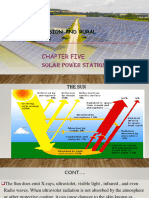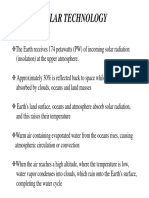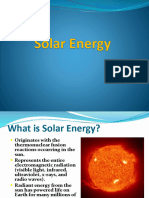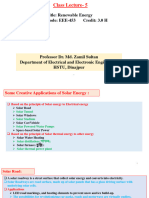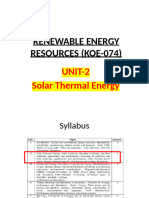Kolektor Parabola
Kolektor Parabola
Uploaded by
hamumarCopyright:
Available Formats
Kolektor Parabola
Kolektor Parabola
Uploaded by
hamumarOriginal Description:
Copyright
Available Formats
Share this document
Did you find this document useful?
Is this content inappropriate?
Copyright:
Available Formats
Kolektor Parabola
Kolektor Parabola
Uploaded by
hamumarCopyright:
Available Formats
Solar Concentrating Collectors
Introduction
For applications such as air conditioning, central power generation, and numerous industrial heat requirements, flat plate collectors generally cannot provide carrier fluids at temperatures sufficiently elevated to be effective. Alternatively, more complex and expensive concentrating collectors can be used. These are devices that optically reflect and focus incident solar energy onto a small receiving area. As a result of this concentration, the intensity of the solar energy is magnified, and the temperatures that can be achieved at the receiver (called the "target") can approach several hundred or even several thousand degrees Celsius. The concentrators must move to track the sun if they are to perform effectively
Concentrating collectors
Concentrating, or focusing, collectors intercept direct radiation over a large area and focus it onto a small absorber area. These collectors can provide high temperatures more efficiently than flat-plate collectors, since the absorption surface area is much smaller. However, diffused sky radiation cannot be focused onto the absorber. Most concentrating collectors require mechanical equipment that constantly orients the collectors toward the sun and keeps the absorber at the point of focus. Therefore; there are many types of concentrating collectors
Types of concentrating collectors
There are four basic types of concentrating collectors:
Parabolic trough system Parabolic dish Power tower Stationary concentrating collectors
Parabolic trough system
Parabolic troughs are devices that are shaped like the letter u. The troughs concentrate sunlight onto a receiver tube that is positioned along the focal line of the trough.
Figure 3.1.1 Crossection of parabolic trough
Figure 3.1.2 Parabolic trough system
Parabolic troughs often use single-axis or dual-axis tracking
Figure 3.1.3 One Axis Tracking Parabolic Trough with Axis Oriented E-W
Figure 3.1.4 Two Axis Tracking Concentrator
Temperatures at the receiver can reach 400 C and produce steam for generating electricity. Multi-megawatt power plants have been built using parabolic troughs combined with gas turbines (California).
Figure 3.1.5 Parabolic trough combined with gas turbines
Parabolic dish systems
A parabolic dish collector is similar in appearance to a large satellite dish, but has mirror-like reflectors and an absorber at the focal point. It uses a dual axis sun tracker
Figure 3.2.1 Crossection of parabolic dish
A parabolic dish system uses a computer to track the sun and concentrate the sun's rays onto a receiver located at the focal point in front of the dish. Parabolic dish systems can reach 1000 C at the receiver.
Power tower system
A heliostat uses a field of dual axis sun trackers that direct solar energy to a large absorber located on a tower. To date the only application for the heliostat collector is power generation in a system called the power tower (solar tower)
Figure 3.3.1 Power tower system
Figure 3.3.2 Heliostats
A heliostat (from helios, the Greek word for sun, and stat, as in stationary) is a device incorporating a mirror which moves so as to keep reflecting sunlight toward a predetermined target or receiver, despite the sun's apparent motions in the sky. The target is stationary relative to the heliostat, so the light is reflected in a fixed direction. Most modern heliostats are controlled by computers. The computer is given the heliostat's position on the earth (latitude and longitude) and the time and date, and uses them to calculate the direction of the sun as seen from the mirror.
A power tower has a field of large mirrors that follow the sun's path across the sky. The mirrors concentrate sunlight onto a receiver on top of a high tower. A computer keeps the mirrors aligned so the reflected rays of the sun are always aimed at the receiver, where temperatures well above 1000C can be reached. High-pressure steam is generated to produce electricity.
Figure 3.3.3 Power tower system with heliostats
Stationary concentrating solar collectors
Stationary concentrating collectors use compound parabolic reflectors and flat reflectors for directing solar energy to an accompanying absorber or aperture through a wide acceptance angle. The wide acceptance angle for these reflectors eliminates the need for a sun tracker.
Working principles of concentrating collectors
Unlike solar (photovoltaic) cells, which use light to produce electricity, concentrating solar power systems generate electricity with heat. Concentrating solar collectors use mirrors and lenses to concentrate and focus sunlight onto a thermal receiver, similar to a boiler tube. The receiver absorbs and converts sunlight into heat. The heat is then transported to a steam generator or engine where it is converted into electricity. A concentrating solar power system that produces 350 MW of electricity displaces the energy equivalent of 2.3 million barrels of oil .
You might also like
- Seminar ReportDocument19 pagesSeminar ReportAjit867588% (8)
- Lecture On SolarconcentratingcollectorsDocument14 pagesLecture On Solarconcentratingcollectorsanmn123100% (2)
- Concentrating CollectorDocument57 pagesConcentrating CollectorSunil PandeyNo ratings yet
- Lecture TwoDocument43 pagesLecture TwowaleedyehiaNo ratings yet
- Unit 2 Solar Thermal EnergyDocument35 pagesUnit 2 Solar Thermal EnergyAbhishek SharmaNo ratings yet
- I.T.S Engineering College, Greater Noida.: Subject CodeDocument18 pagesI.T.S Engineering College, Greater Noida.: Subject Codeaman jainNo ratings yet
- Concentrating Collectors: Concentrated Solar Power (CSP)Document24 pagesConcentrating Collectors: Concentrated Solar Power (CSP)shantanubanerjee.mec24No ratings yet
- Solar Energy and Solar PanelDocument19 pagesSolar Energy and Solar Panelkum1242No ratings yet
- res-unit 2,3,4Document218 pagesres-unit 2,3,4Kumara SwamyNo ratings yet
- Analysis of Solar Thermal Power Generation ReportDocument19 pagesAnalysis of Solar Thermal Power Generation ReportJolly Rose Gonzales100% (1)
- Alternative Sources of Energy Unit 1Document5 pagesAlternative Sources of Energy Unit 1Avinash Kumar (RA1911001030001)No ratings yet
- 3.Concentrated CollectorsDocument34 pages3.Concentrated CollectorsANITHARANI KNo ratings yet
- SPT ReportDocument16 pagesSPT ReportAbhishek AwasthiNo ratings yet
- Group 2 AssignmentDocument24 pagesGroup 2 AssignmentJoyce MusunguNo ratings yet
- Solar Concentrators (Parabolic Trough, Parabolic Dish, CentralDocument34 pagesSolar Concentrators (Parabolic Trough, Parabolic Dish, Centralabhilashkrishnantk100% (2)
- Seminar ReportDocument19 pagesSeminar ReportksiojiohyuiNo ratings yet
- ReportDocument5 pagesReportClayssaNelNo ratings yet
- Operation and Maintenance Methods in Solar Power Plants: Mustapha HattiDocument34 pagesOperation and Maintenance Methods in Solar Power Plants: Mustapha HattiRedouan LerhrissiNo ratings yet
- (Concentrating Solar Power CSP) : Text TranslationDocument3 pages(Concentrating Solar Power CSP) : Text TranslationKhelidja DhmNo ratings yet
- Solution of Tutorial 02Document5 pagesSolution of Tutorial 02mauryaakki26548No ratings yet
- Eceg - 4242-SOLARDocument97 pagesEceg - 4242-SOLARaloitagu12No ratings yet
- Chapter Three High Temperature Solar ThermalcDocument21 pagesChapter Three High Temperature Solar ThermalcalukardlibroNo ratings yet
- Solar Power TecnologyDocument35 pagesSolar Power TecnologyNyityo PeterNo ratings yet
- Offshore Solar EnergyDocument3 pagesOffshore Solar EnergyIshwarya SrikanthNo ratings yet
- 3 Solar EnergyDocument65 pages3 Solar EnergyMuhammed MuhsinNo ratings yet
- Types of ConcentratorsDocument7 pagesTypes of ConcentratorsNissanth KNo ratings yet
- Evacuated Tube Collectors: Heat Absorbing Sunlight Electromagnetic Radiation Infrared Ultraviolet Solar ConstantDocument11 pagesEvacuated Tube Collectors: Heat Absorbing Sunlight Electromagnetic Radiation Infrared Ultraviolet Solar ConstantSanchitNo ratings yet
- Energy ResourcesDocument40 pagesEnergy ResourcesKim Howard CastilloNo ratings yet
- Lecture CSP ConcentratedDocument12 pagesLecture CSP Concentratedziafat shehzad100% (1)
- Solar Cells: G. Ram Kumar MVGR College of EngineeringDocument14 pagesSolar Cells: G. Ram Kumar MVGR College of Engineeringrk_gummaluri5334No ratings yet
- Solar DishDocument17 pagesSolar DisharhlboyNo ratings yet
- Solar EnergyDocument22 pagesSolar EnergyJever Dave LatorreNo ratings yet
- Comparative Study of Various Solar Thermal Systems: Stage Ii Project Presentation OnDocument70 pagesComparative Study of Various Solar Thermal Systems: Stage Ii Project Presentation OnSaurabh ChoudharyNo ratings yet
- Res Unit 2.Document25 pagesRes Unit 2.517Shrishti MouryaNo ratings yet
- Haidee Concentrating Solar PowerDocument3 pagesHaidee Concentrating Solar PowerXlashNo ratings yet
- 2023 08 13 Renewable Energy Lec 5 v2Document23 pages2023 08 13 Renewable Energy Lec 5 v2Tabibar RahmanNo ratings yet
- G J E S R: Lobal Ournal of Ngineering Cience and EsearchesDocument6 pagesG J E S R: Lobal Ournal of Ngineering Cience and Esearchesmohammedshoaib1033No ratings yet
- RES-Solar CollectorsDocument55 pagesRES-Solar Collectorsasfvkjsv asgbaegbNo ratings yet
- Concentrating Solar Power SystemsDocument12 pagesConcentrating Solar Power SystemsNaveen GowdaNo ratings yet
- Unit 2: Solar Energy CollectionDocument40 pagesUnit 2: Solar Energy CollectionJaya RajNo ratings yet
- Solar Energy Collectors: Absorbs The Incoming Solar Radiation Transfers This Heat To A FluidDocument30 pagesSolar Energy Collectors: Absorbs The Incoming Solar Radiation Transfers This Heat To A FluidM RAVI KISHORENo ratings yet
- Tesla - (Ebook) Free Energy - Concentrating Solar Power - Energy From Mirrors PDFDocument6 pagesTesla - (Ebook) Free Energy - Concentrating Solar Power - Energy From Mirrors PDFgubem100% (1)
- Unit2 Solar Thermal EnergyDocument66 pagesUnit2 Solar Thermal EnergyAbhishek SrivastavaNo ratings yet
- Solar Power GenerationDocument17 pagesSolar Power GenerationyrikkiNo ratings yet
- BY, Pankaj Kumar Tiwari REGISTRATION NO. - 0801214347 Semester - Seven Branch-Electrical EngineeringDocument23 pagesBY, Pankaj Kumar Tiwari REGISTRATION NO. - 0801214347 Semester - Seven Branch-Electrical EngineeringDev KumarNo ratings yet
- تأشيرات الشرحيات المطلوبة5Document6 pagesتأشيرات الشرحيات المطلوبة5احمد كريم خلفNo ratings yet
- Seminar On Solar Power GenerationDocument17 pagesSeminar On Solar Power GenerationJasvir Singh100% (2)
- Solar Thermal PowerDocument30 pagesSolar Thermal Powerveerakumars0% (1)
- Chapter 3Document25 pagesChapter 3harinatha778No ratings yet
- Turbine Technology in CarDocument25 pagesTurbine Technology in CarJayant DeshmukhNo ratings yet
- Module 2Document86 pagesModule 2bharath149No ratings yet
- Types of Concentrating Solar CollectorsDocument6 pagesTypes of Concentrating Solar Collectorsshivam agarwal0% (1)
- Solar Trough SystemDocument3 pagesSolar Trough SystemHashem Mohamed HashemNo ratings yet
- Solar - Thermal - Energy Mohammad AlrashdanDocument26 pagesSolar - Thermal - Energy Mohammad Alrashdanمحمد الرشدانNo ratings yet
- Solar energy part 2Document18 pagesSolar energy part 2namiabdellatif3No ratings yet
- AbstractDocument7 pagesAbstractnest dtpNo ratings yet
- Concentrated Solar CollectorsDocument4 pagesConcentrated Solar CollectorsLima CostaNo ratings yet
- How to Install & Design Solar Panels Like a ProfessionalFrom EverandHow to Install & Design Solar Panels Like a ProfessionalNo ratings yet
- Basic Off-grid & On-grid Design Solar Systems from Scratch: Bonus: Guide to Project Design in Autodesk© Autocad©.From EverandBasic Off-grid & On-grid Design Solar Systems from Scratch: Bonus: Guide to Project Design in Autodesk© Autocad©.Rating: 5 out of 5 stars5/5 (1)
- ASME Vessel Spec DataDocument3 pagesASME Vessel Spec DataShanavas BavuNo ratings yet
- Evaporative Cooling SystemsDocument22 pagesEvaporative Cooling Systemsbcap-oceanNo ratings yet
- Unit 1 Dynamics of MachineryDocument17 pagesUnit 1 Dynamics of Machineryswetha shree chavan mNo ratings yet
- FULLTEXT01Document82 pagesFULLTEXT01Khelil OmarNo ratings yet
- Supplementary ProblemsDocument3 pagesSupplementary Problems白銀0% (1)
- Plate 2 (A Quantitative Approach of Seepage Analysis)Document6 pagesPlate 2 (A Quantitative Approach of Seepage Analysis)Robert Michael TampusNo ratings yet
- Extinguishing Techniques in Confined Spaces. Shan Raffel GIFireEDocument4 pagesExtinguishing Techniques in Confined Spaces. Shan Raffel GIFireEShan RaffelNo ratings yet
- LPG 1 PDFDocument8 pagesLPG 1 PDFHarshitgpt1231No ratings yet
- Design of Flange JointDocument14 pagesDesign of Flange Jointmichal_lysy100% (2)
- Ae BracketDocument16 pagesAe BracketIvan PasterNo ratings yet
- DVS Technical Codes On Plastics Joining TechnologiesDocument11 pagesDVS Technical Codes On Plastics Joining TechnologiesHaseeb ZahidNo ratings yet
- Quarry Dust 2022Document3 pagesQuarry Dust 2022WilliamNo ratings yet
- Movement and Position 1 QPDocument12 pagesMovement and Position 1 QPMay Htet KhinNo ratings yet
- Simple Super MacroMicroscope Webcam ConversionDocument7 pagesSimple Super MacroMicroscope Webcam ConversionClark McCulloughNo ratings yet
- SG - Iron Heat TreatmenDocument10 pagesSG - Iron Heat TreatmenMuhammad AbrarNo ratings yet
- Plate Tectonics: A Scientific Theory UnfoldsDocument47 pagesPlate Tectonics: A Scientific Theory UnfoldslisaNo ratings yet
- Thermal Properties of Matter JEE Main 2023 (January) Chapter-Wise Qs BankDocument19 pagesThermal Properties of Matter JEE Main 2023 (January) Chapter-Wise Qs BankAvijit baruiNo ratings yet
- Ce2404 Notes QN Answers RejinpaulDocument65 pagesCe2404 Notes QN Answers RejinpaulthulasicivillllNo ratings yet
- Andrade EqDocument10 pagesAndrade EqHima Bindu KolliNo ratings yet
- Fabrication and A Demonstration of Air Compressor: Bachelor of Technology IN Department of Mechanical EngineeringDocument8 pagesFabrication and A Demonstration of Air Compressor: Bachelor of Technology IN Department of Mechanical EngineeringPraveenNo ratings yet
- 15 - 217 Helical Ribbon Mixer EvaluationDocument8 pages15 - 217 Helical Ribbon Mixer EvaluationdausykNo ratings yet
- Flashcards - Investigating Solubility - Edexcel Chemistry IGCSEDocument17 pagesFlashcards - Investigating Solubility - Edexcel Chemistry IGCSEsohaila ibrahimNo ratings yet
- A 14 A - Hygroscopicity: GEA Niro Method No. A 14 ADocument3 pagesA 14 A - Hygroscopicity: GEA Niro Method No. A 14 AjoshNo ratings yet
- Mixture NotesDocument3 pagesMixture NotesYoNo ratings yet
- Introduction To OCTG: API Steel Grades Handout 03Document4 pagesIntroduction To OCTG: API Steel Grades Handout 03AHMEDNo ratings yet
- Catalog PDFDocument154 pagesCatalog PDFRingroup Seals100% (1)
- Capabilities Chart: GeneralDocument3 pagesCapabilities Chart: GeneralFernando Acevedo FernandezNo ratings yet
- Sound WavesDocument28 pagesSound WavesSnehal NayakNo ratings yet
- International Journal of Heat and Mass Transfer: Peter Lloyd Woodfield, Aloke Kumar Mozumder, Masanori MondeDocument6 pagesInternational Journal of Heat and Mass Transfer: Peter Lloyd Woodfield, Aloke Kumar Mozumder, Masanori MondeRanjith RNNo ratings yet
- SLOPEWDocument4 pagesSLOPEWBraian LlanosNo ratings yet




















